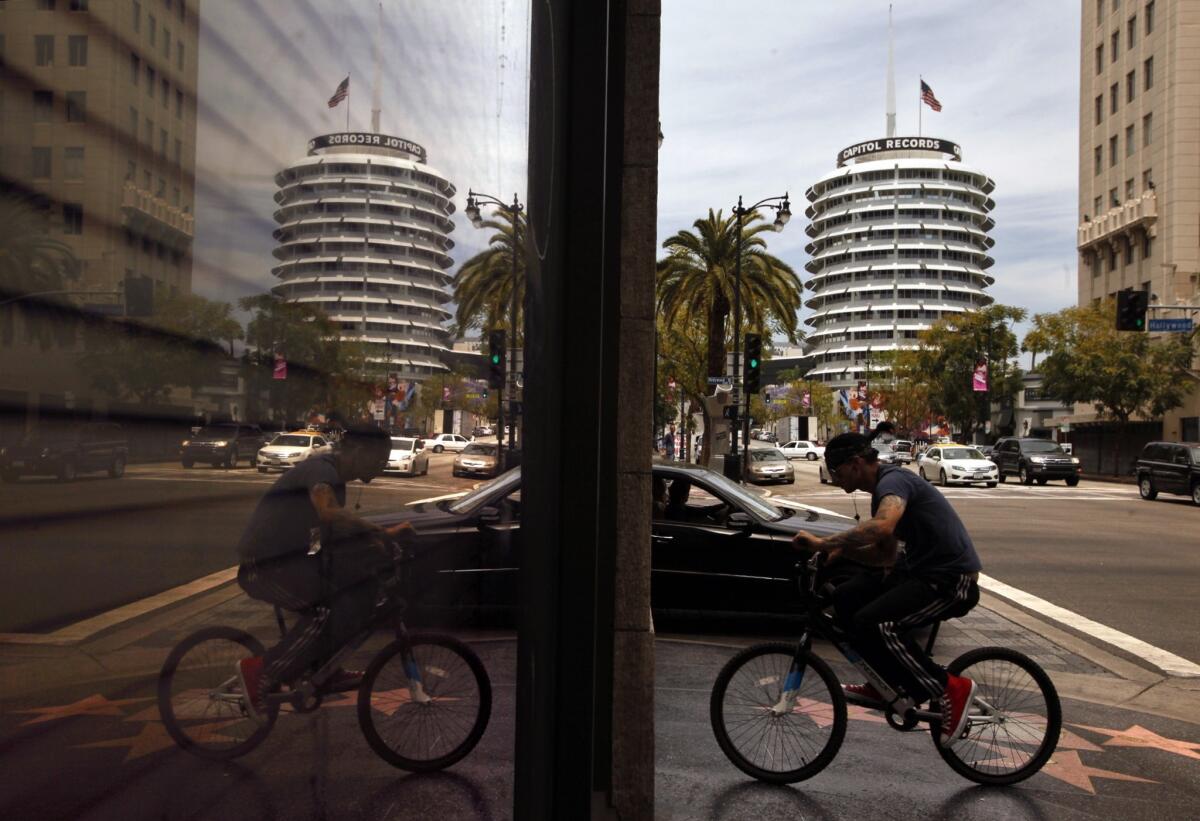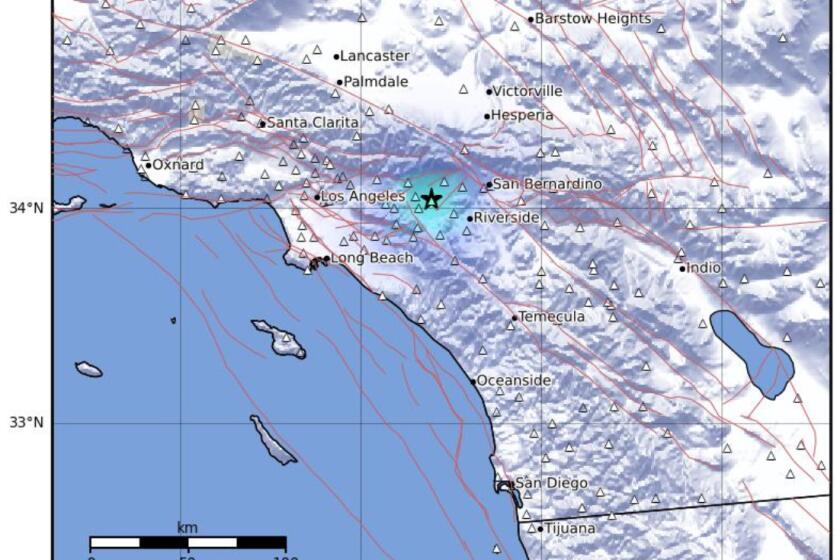Preliminary quake map shows fault lines under schools, hotels, homes

Nearly a century ago, as Hollywood rose from lemon groves, St. Stephen’s Episcopal Church was built on a steep slope near Yucca Street.
But it was only this year that the pastor found out his church may lie atop an earthquake fault capable of tearing it in two.
In January, the California Geological Survey issued preliminary fault maps for Los Angeles County for the first time in nearly two decades. One of the maps shows the approximate path of the Hollywood fault going directly under the church.
The mapped fault lines cut through more than 1,500 developed properties, according to a Times analysis of maps of the Hollywood fault and the Sierra Madre and Duarte faults in the northern San Gabriel Valley.
Preschools, senior housing, luxury hotels on the Sunset Strip, one of San Gabriel Valley’s largest housing developments and Bradbury’s City Hall were built along hillsides that geologists say were formed by earthquakes.
The buildings include landmarks such as the Capitol Records tower in Hollywood, the Mondrian and Standard hotels in West Hollywood, three elementary schools, a performing arts college and Immaculate Heart High School and Middle School.
A total of about 12,000 properties lie in the newly drawn fault zones, roughly 500 feet on each side of estimated fault lines.
State law prohibits new construction on faults. Once the state finalizes the maps — a decision expected later this year after public hearings and appeals — development will be restricted within the fault zones. Owners wanting to build would have to do underground seismic testing, which is the only definitive way to locate a fault.
For building owners, the maps raise legal and moral issues.
“There’s a lot of unanswered questions,” said Jaime Edwards-Acton, senior pastor at St. Stephen’s. “We have to figure out: Do we have to change anything?”
If a building lies on a fault, there is no engineering solution to resist the movement of the earth in opposite directions, said State Geologist John Parrish.
The remedy would be to tear down the building and rebuild away from the fault, something that would not be feasible for most properties in densely populated areas.
Single-family homes make up about 3 out of 4 properties in the zones. Their owners generally have one option: Live with the risk and, as required by state law, inform future buyers the house is in a fault zone.
But for others, the choice is much more complex.
::
Public schools reacted quickly to the new fault maps.
The Los Angeles Unified School District has begun an underground study to see whether the Hollywood fault runs underneath Atwater Avenue Elementary School. In the past, L.A. Unified has demolished classroom buildings found to be on top of faults.
The Azusa Unified School District has also begun searching for the fault shown crossing the campus of Charles Lee Elementary School.
Other school districts have routinely razed classrooms that have faults underneath.
“If you knowingly have a population inhabiting them, you’ve got not only a legal but a moral obligation to address it,” said Denise Whittaker, former president of San Bernardino Valley College, which demolished seven buildings along the San Jacinto fault in the 2000s.
Legal counsel advised the district’s board “that if they didn’t fix the buildings … they were personally liable,” said the chancellor at the time, Donald Averill.
Unlike public school trustees, who deliberate in public and can tap public funds, the leaders of two private schools are saying little about what they will do.
“We have and will continue to take responsive steps — including the review and assessment of our own particular site — and action, if necessary,” said Julie McCormick, president of Immaculate Heart High School and Middle School. “The safety of our students and faculty is our highest priority.”
“We are taking all of this very seriously,” said Ted Hamory, head of the Oaks School, a $21,000-a-year private elementary school that leases space in Hollywood United Methodist Church.
“We are consulting with experts to help us determine the potential impact of this new information and to help us plan accordingly,” he said.
::
Luxury hotels on the Sunset Strip in West Hollywood — the Mondrian, the Sunset Tower and the Standard — illustrate the delicate public relations problem facing owners of highly valuable properties.
The Standard “will take necessary precautions to ensure the safety of their guests, which could potentially include structural assessment or seismic investigation,” spokeswoman Kaitlin Kominsky said.
Representatives of the Sunset Tower and the Mondrian declined to comment.
Dealing with the earthquake risk is complicated by uncertainty among scientists about exactly where the faults actually lie.
In some areas, state geologists are fairly certain of fault locations based on such features as the hill St. Stephen’s sits upon or sharp changes in the soil, rock and groundwater levels. Along other sections, scientists have estimated the path of faults by connecting points where a fault has been identified through excavation. Also, unidentified fault strands could extend away from the main path.
Seismic experts consider underground studies the best way to determine the path of a fault. But even that may not always be definitive, if, for example, the trench is not dug deep enough.
The Royal Oaks senior living center near Bradbury took what its owner thought were reasonable precautions before constructing a new building in the 1990s. It hired geologists to dig trenches, and they concluded there was no fault under the site.
Now the preliminary state map puts a line underneath the building. State geologists say previous trenches weren’t deep enough to be conclusive.
Royal Oaks spokesman Dan Hutson said the owner, be.group, hasn’t decided what to do.
“It’s a tough situation,” Hutson said, adding that displacing seniors may not be the best answer. “For seniors, they’re better off living in a senior living community.… We’ve got 24-hour staff, emergency generators, food and nursing.”
::
The new maps have caught many by surprise, because California had virtually stopped drawing fault zones.
Mapping active earthquake faults is required under the Alquist-Priolo Earthquake Fault Zoning Act, which generally prohibits building over active faults. The state law passed after the 1971 Sylmar earthquake ripped apart many homes directly on top of the San Fernando fault.
State officials were initially aggressive about mapping faults, but budget cuts stalled efforts over the last 20 years. Of an estimated 7,000 miles of active faults in California, 2,000 still need to be mapped — in places such as L.A. County’s Westside, Orange County, Pasadena, Lake Tahoe and the San Diego and San Francisco Bay areas.
Parrish, the state geologist, accelerated the mapping of the Hollywood fault after the Los Angeles City Council approved the controversial Millennium Hollywood skyscraper project despite his warnings that it may fall within a fault zone.
The stakes are high for developers planning multimillion dollar projects.
If developers can satisfy local building officials that a fault does not run under the site, they are free to build. For that reason, owners of high-value properties sometimes obtain their own geological reports to make the case that the fault does not cross their land.
Millennium Partners, which co-owns the Capitol Records building and is seeking to build two skyscrapers next to it, says the state’s fault map is wrong. Millennium’s geologists have taken soil samples and plan to dig a trench.
“We are confident the trenching will corroborate our previous investigations and demonstrate conclusively that no active fault exists on our site,” Philip Aarons, one of the developers at Millennium Partners, said in a statement.
Blvd6200, a large residential and commercial project under construction at 6201 Hollywood Blvd., lies directly in the state’s estimated path of the Hollywood fault.
A geologist hired by the developer monitored the excavation of the site for underground parking and concluded that the fault “is not clearly detectable,” said lawyer John M. Bowman. The state is evaluating the company’s appeal of the fault map. The state’s new fault map would not halt Blvd6200’s construction, which is nearly complete, but the company wants the line removed.
The developer of Rosedale, a large master-planned community in Azusa, is making a different argument. Its geologist, Eldon Gath, contends that “an abundance of evidence” shows that a fault crossing underneath several recently constructed homes last caused earthquakes so long ago, “there is no hazard from rupture.”
State geologists reached a different conclusion, saying in January that the fault is active. The California Geological Survey is evaluating the developer’s appeal.
Some property owners say they can’t afford to hire a geologist to conduct a study, which can cost tens of thousands of dollars.
Pastor Edwards-Acton of St. Stephen’s, which has a preschool attached, said he doesn’t know where the church will find the money needed to learn more about the fault.
“I don’t know what the resources are to address these things,” Edwards-Acton said. “Is the state going to step up? Who helps?”
More to Read
Sign up for Essential California
The most important California stories and recommendations in your inbox every morning.
You may occasionally receive promotional content from the Los Angeles Times.












